By Philip Lee
Why Tibet and who joined?
Tibet has always been on top of my list of places where I want to travel in China because of its remoteness and its religious mysticism. My wife Magdalen, however, does not share the same yearnings towards Tibet because she was worried about our age and the likelihood of altitude sickness. So when the news that Jeffrey and Ming were actively recruiting classmates for a Tibet trip reached us early this year, I knew the opportunity had arrived. I registered my interest for the trip.
The September 2016 WYK64 Reunion had laid the groundwork for the Tibet trip as Magdalen got on well with Ming's wife, Helena, who shared her passion for ballroom dancing and we had agreed to meet up in Sydney after the reunion. In the meantime, Jeffrey and Ming sent out an invitation to all alumni to join them in their proposed Tibet trip in June. We were in Shanghai at the time so we expressed interest to join. When we got back I arranged to meet with Ming and Helena in Sydney mid-February over lunch to discuss the trip. Ming told us that a number of classmates had considered the possibility of high altitude sickness and conditions of their health and had declined to join so we ended up with just Ming, Helena, Magdalen and I.
Departure from Guangzhou
Magdalen and I flew to Guangzhou from Sydney and stayed in Ming and Helena's spacious apartment overlooking the Pearl River and spent 2 hot summer days shopping in Guangzhou's famous walking street, Beijing Road, and visiting Sun Yat-sen Memorial. Ming treated us for lunch and demonstrated his tea-tasting skills 茶艺 with a fine selection of Guangzhou's delicious Dimsim varieties. He also showcased Cantonese food such as low-fired soup 老火汤, soya sause Goose, steamed Waan Fish. On the night before the trip we had a change of palate in a binge of Shanghaiese steamed buns, spiced jiaozi and pork with water duck soup. Ming and Helena were perfect hosts.
Our flight from Guangzhou to Xining took two and half hours. It had a fair bit of air turbulence on the descent on Xining's Caojiabao Airport probably due to its high altitude at over 2275 m. above sea level. The weather was cloudy but pleasant. We were picked-up and taken to Sofitel Hotel in the centre of town.
Background info on Xining
Xining is a city of about 5 million, half of which are Han migrants from other parts of China and the rest are Tujia, Zang (Tibetan) and Hui Nationalities: Tujia and Zang are Buddhists and Hui Nationality are Moslems. We were told that the Hans are mainly concentrated in Xining and neighboring counties because they have issues with high altitude environments. On first sights of the high-rise blocks of apartments, one can be forgiven that they can be in any city in China. This impression is reinforced by the presence of Wanda Property Development Company which is responsible for most of the high-rise housing complexes in the city in the last few years. Our guide told us that there was not a single high rise when she arrived 10 years ago which was indicative of the development of the city in the last 10 years. Some people would equate the number of high rise in Xining as evidence of progress. To me, I can see progress being made in terms of the hundreds of thousands of trees being planted on the side of hills surrounding the city. When I enquired about them, our guide told us that it is mandatory for government and enterprises to send their employees to plant trees as part of their contribution to their communities.
A Search for our roots from Chinese mythology - Nuwo 女娲
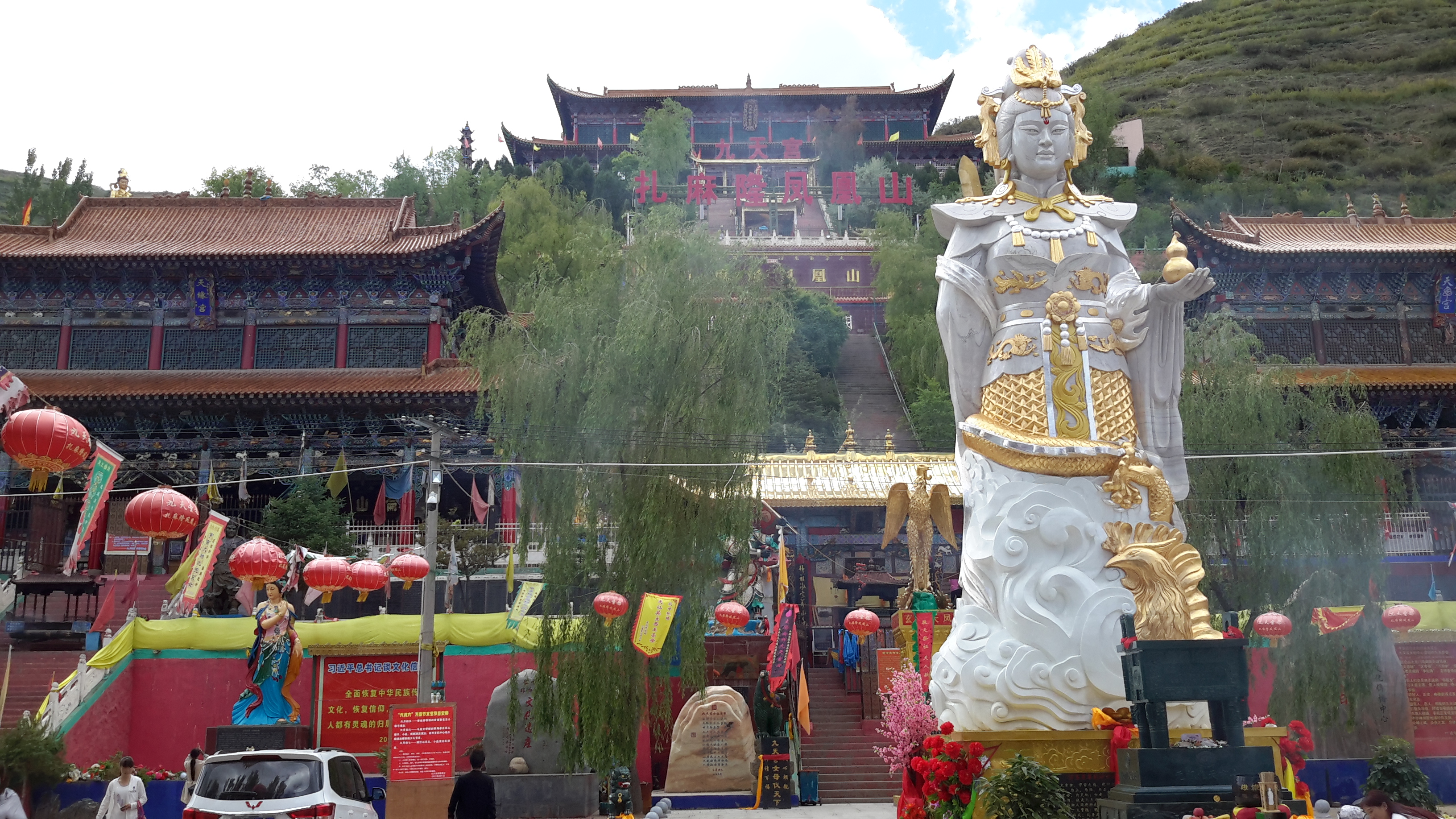
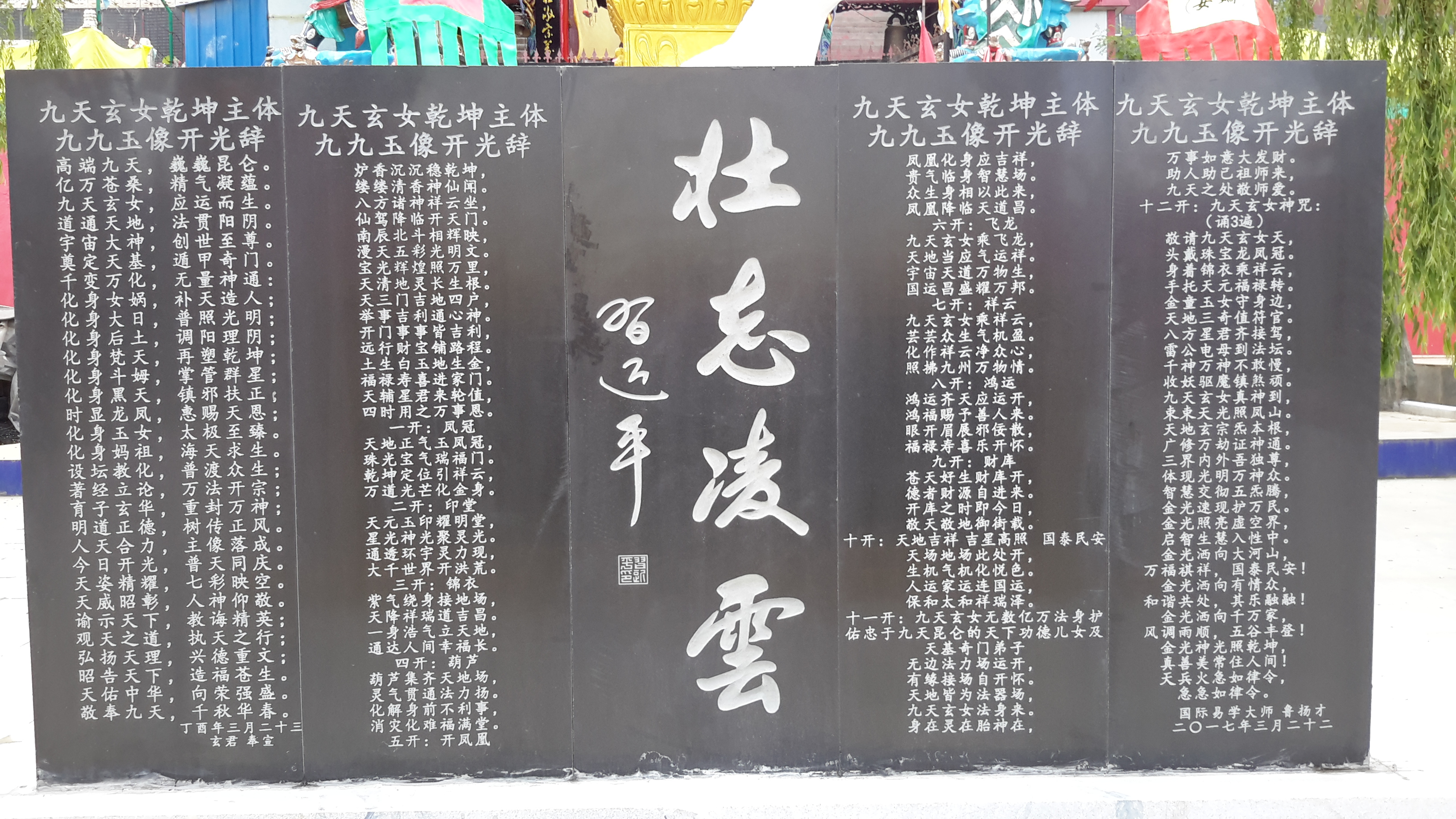
After a hotpot lunch with Tibetan white tea, we set off for Jiutianxuan Palace 九天玄女宫 which honoured our Chinese ancestor, Nuwo. The Chinese palace features a huge size statue of Nuwo at the centre looking down the hill with lesser deities including Guan Yu 关羽, Zhangf Fei 张飞, Nuo Zha 娜吒 and Sun Wukong 孙悟空 guarding the summit at different levels. At the summit is housed Buddha and other gods in a grand hall. At a short distance from the main palace stands the Temple of Chang'e 嫦娥 with 3 tiers of long walls along the side of the hill overlooking a replica of the Altar of Heaven which represents a direct linkage of the Heavens to mankind starting with Nuwo creating man and woman out of mud and finishing with Chinese emperors receiving their mandate from Heaven to rule the Chinese nation as symbolised by the Altar of Heaven. The analogy was not lost when President Xi Jinping inscribed the following words in a tablet to honour Nuwo: Zhuangzhi ling yun 壮志凌云 "With soaring aspirations, (we need to strengthen our civic morality for the revival of our nation)". His mandate to rule comes from the lofty moral ideals in Chinese tradition which he espouses for the benefit of his people (This was noted in another tablet near the base of the Altar of Heaven).
Visiting high school students in Huzhu County
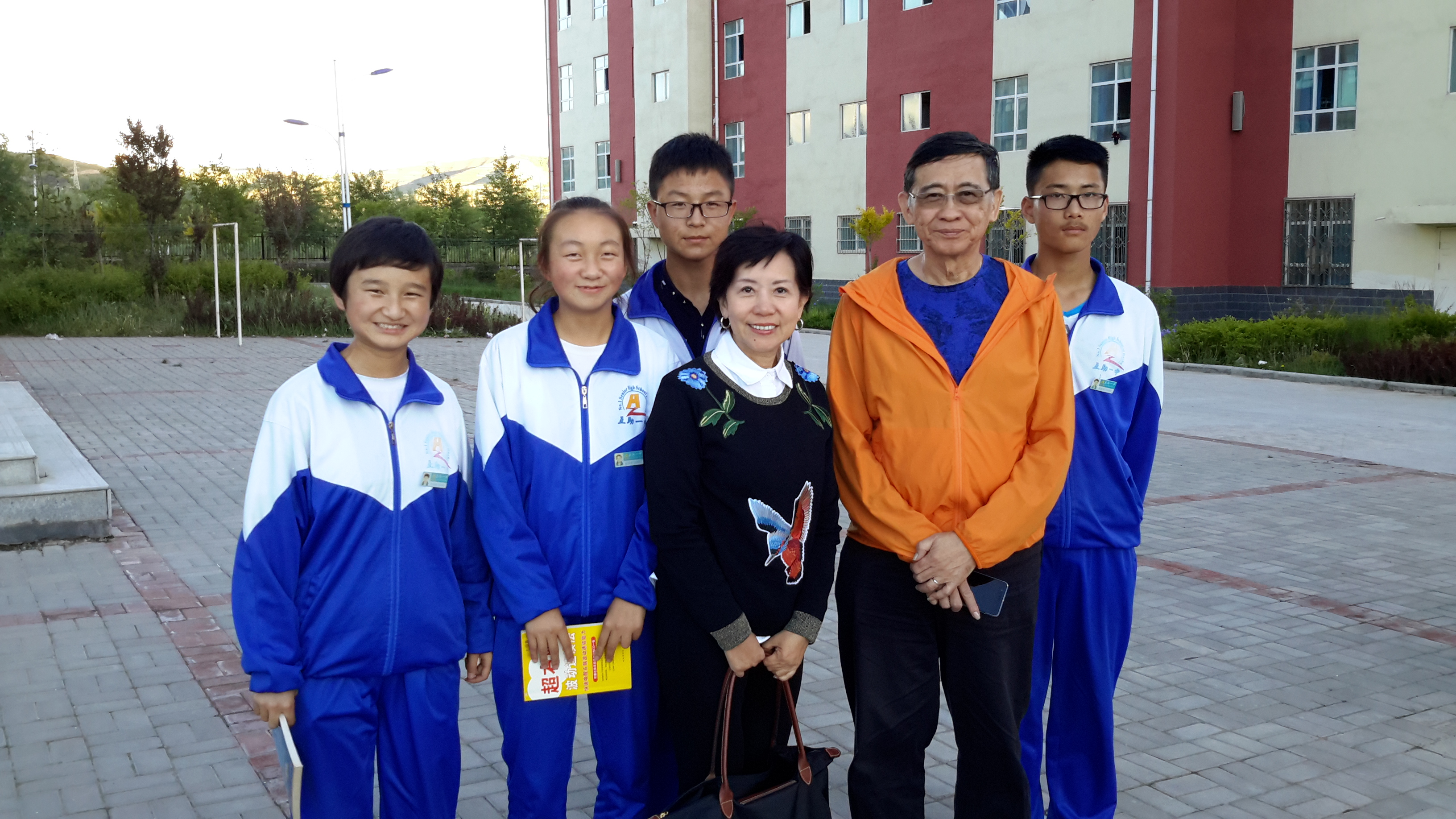
One of the reasons why Ming and Helena chose Xining as a starting point for our Tibet tour was that they wanted to visit the 4 high school students at Huzhu First High School whom they had sponsored. Huzhu County is 45 minutes drive from Xining. Driven by respect for Ming and Helena's philanthropic spirit, we came along to meet the students and their teacher. Ming and Helena sponsored two boys and two girls, all aged 16. One of the boys was of Tujia Nationality. From the report which their teacher gave, they have a bright future ahead of them, so it looks to us that Ming and Helena have spent their money wisely. Prior to the meeting, Ming showed me the touching letters which the students wrote where they poured out their emotions of gratitude for the support they received from Ming. However, they were too young and shy when they met their sponsor for the first time and it took me a while to open them up. Ming took them out of the school to a restaurant for a more relaxed chat. The dinner was sumptuous and it was clear that these poor kids had never seen so much food before in their lives. There were plenty of food left over so we suggested that they took it back to their dormitory to share with their roommates. They were happy to oblige.
Qinghai Lake
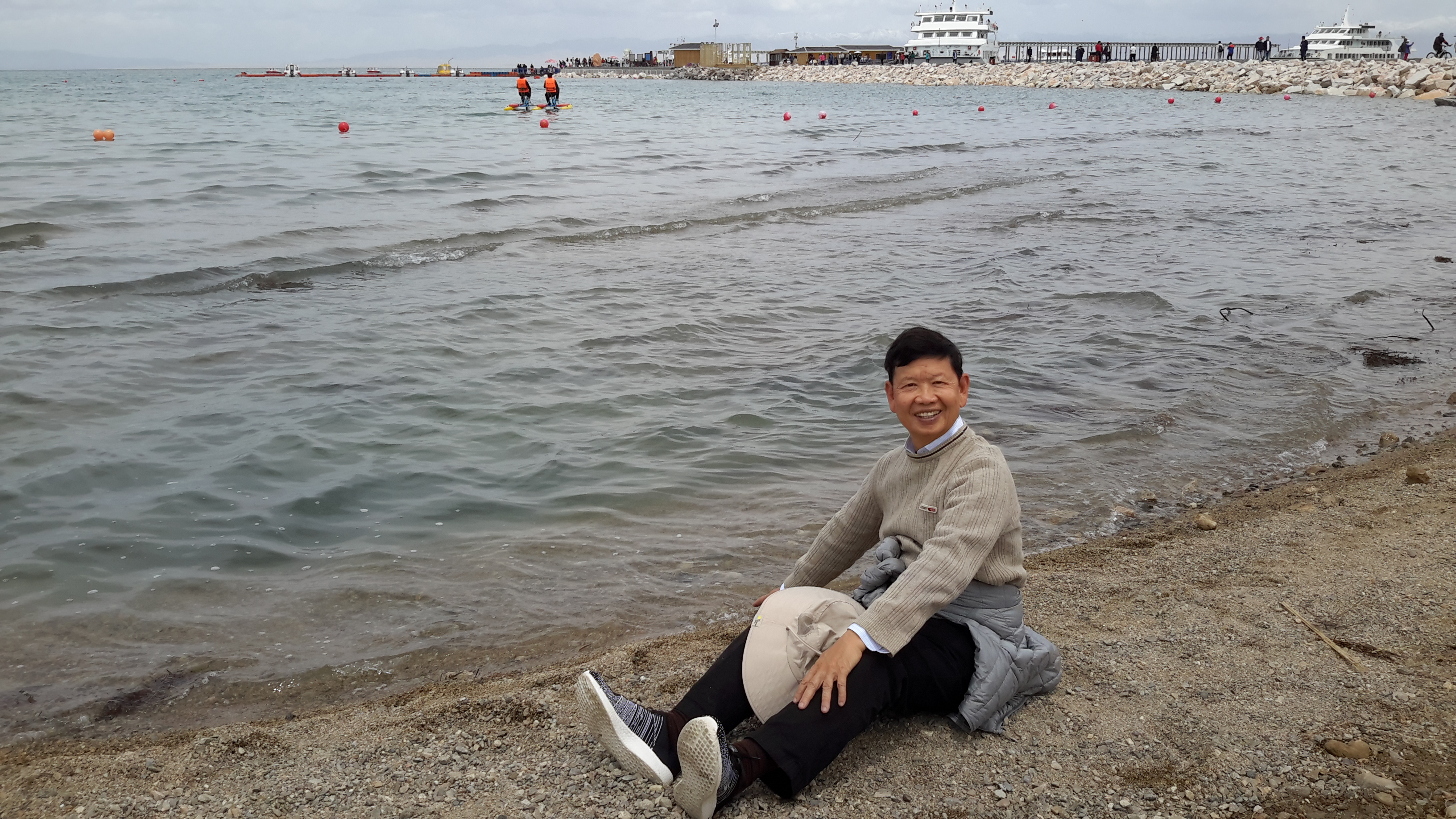
Qinghai Lake was the first official destination in our itinerary in Qinghai as we were supposed to rest on our first day before proceeding on higher altitudes. As it turned out we didn't rest at 2270 m. because we had slotted in the impromptu visit to Jiutianxuan Palace and met Ming's sponsored students. The next day we began our 2 hours' drive to Qinghai Lake, forgetting that we would ascend another 1000 m. along the 130 km journey before reaching Qinghai Lake. Luckily none of us were affected by the higher altitude even without medication. The drive from Xining to Qinghai Lake was quite scenic with yaks and sheep and wild horses dotted the grassland along the way. There were even camels and buggies for tourists to ride on sand dunes which frightened bird life and spoiled the tranquility of the wilderness setting. We arrived at the official lake entrance and began our walk to the edge of the lake. Conscious of the altitude of 3205m, our guide told us to slow down our pace but I was too excited to take as many photos as I could so I had to rush to get back to our group and as a result I was grasping for breath. Finally we reached the lakeside and were greeted by a cluster of Tibetan Buddhist icons such as prayers (Sutra) Streamers,Tibetan pagoda (Stupa) surrounded by prayer wheels with an inclined Sakyamuni Buddha in the middle. Beyond these icons, there was a wharf for tourists to take their boat ride into the lake. Finally we got to the edge of the Lake and I reached out to touch the water of the lake as proof that I had finally realised my childhood dream of getting to Qinghai Lake!
Guide Geological Park
I had heard of some colourful canyons in Qinghai so I made a request to include them in our itinerary. Luckily it so happened that Guide Geological Park 贵德地质公园 was just 50 km away on our return journey to Xining. We arrived at the Park an hour before closing time to catch the last guided tour and that was enough to satisfy our hunger for information. Although the canyon itself was much smaller than Crystal Palace in Arizona in the US, the colours of the canyon was unique and awesome. In terms of landscape, it was a complete change of scenery to Qinghai Lake which tended to be monotonous and flat. Not having the benefit of visiting Crystal Palace in Arizona, Ming was thankful that I made the request to our guide to include the Guide Canyons in our itinerary.
Kumbum Monastery
On our last day in Xining, we visited the most important monastery in Qinghai, Kumbum Monastery which was known as Ta'er Temple 塔尔寺 in Chinese. It was founded in 1583 and ranked second only to Potala Palace in Lhasa. In terms of size and space, it is actually bigger than Potala Palace as we later found out. We met Buddhist pilgrims from as far as Liaoning in North-East China who traveled for months to get there. Ming turned out to be a devout Buddhist as he listened attentively to the official guide on the history of the Monastery and paid his respects to all the Buddha and Lamas related to this sacred place.
Our train journey on the Qinghai-Tibet Railway
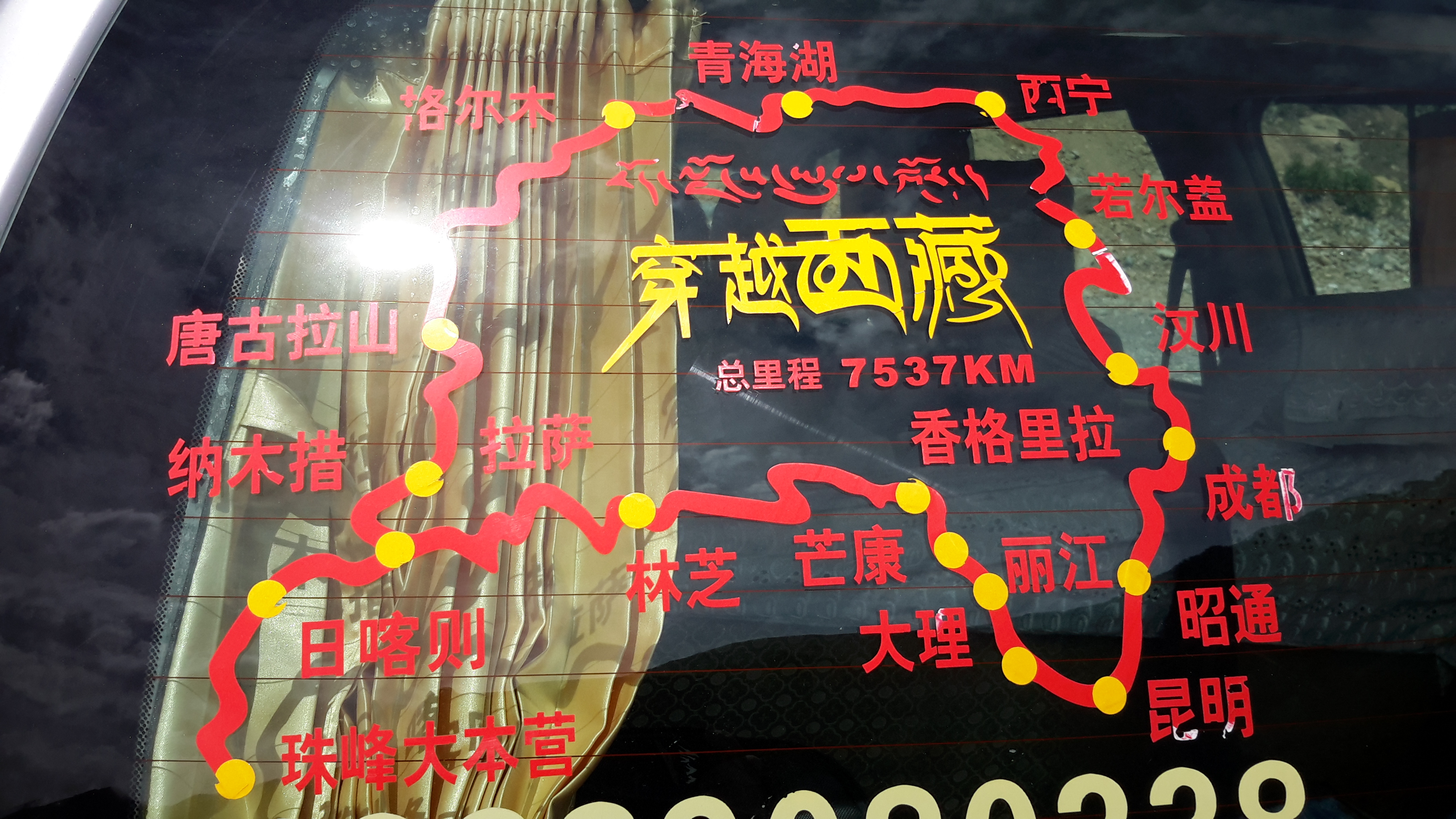
One of the highlights of our trip to Tibet was to get on the Qinghai-Tibet Railway 青藏铁路 from Xining to Lhasa. There were many trains which originated elsewhere and only stopped at Xining briefly to get on the Qinghai-Tibet Line. Ming was particular about the train which originated from Xining because it was only operational since October 2006 and this was his reason for choosing Xining as the starting point for our Tibet trip. As there were only 2 trains which operated daily from Xining which took 22 hours, he picked the 2:00 pm train with a view to see the first part of the journey at daylight. Many statistics on the Qingzang Railway have suggested that we should get on this high-elevation train apart from the scenery along the journey: The line includes the Tanggula Pass 唐古拉山关口 which rises 5,072 m above sea level with the highest rail tunnel at elevation 4,905 m and the longest tunnel at 3,700 m. Over 960 km of the rail is at an elevation of more than 4,000 m above sea level with 675 bridges totalling 160 km and about 550 km of track is laid on permafrost. We were told that we would pass the Tanggula Pass at around 2:00am so I made a point to wake up before that time to experience the altitude and true enough, I felt my head was heavy at the time but the train pumped oxygen into our soft-bed cabin and I felt better. In the darkness, I saw Ming was awaken on the occasion, too, while the ladies were sound asleep not knowing what had happened. The next day we were on lower altitude averaging 4,000 m and the scenery was so spectacular even to die for. I took over 600 photos along the way before we reached Lhasa.
Potala Palace: the domain of the Dalai Lama

We spent day 1 of our arrival to Lhasa resting in our hotel, acclimatising and had our first taste of yak with curry at dinner time. From our hotel we could see Potala Palace 布达拉宫 rising from the base of a hill to dominate the landscape of the city. Images of the Potala Palace have always intrigued me even though we have been to Labuleng Temple 拉布楞寺 in Xiahe 夏河, Gansu 甘肃 which is another shrine in Tibetan Buddhism. Potala Palace is special because it was built by Songtsan Gampo 松赞干布 and his Chinese wife, Princess Wencheng 文城公主in the Tang Dynasty. In the 17th century it became the winter palace of the Dalai Lama and the centre of Tibetan Government. The structure was divided into the White Palace and the Red Palace. It has 13 levels reaching 115.7 m high. We only went up to the 12th level as the top floor was closed to the public. 800 monks live and work in the Palace. We arrived early to the palace gate at around 8:30am to make sure that we could get to see all the rooms in the palace as the quota for the day was 3000. Among the tourists there were many Tibetan pilgrims who traveled from different parts of Tibet to get to see the myriad of murals, painted scrolls, sutras and gilded burial stupas of past Dalai Lamas. Ming and Helena are devout Buddhists so the visit was a sort of pilgrimage to them as they listened to the guide attentively and paid their respects wherever they passed a Buddha or Dalai Lama. I am a non-believer but have found the experience quite overwhelming.
Jokhang Temple Monastery
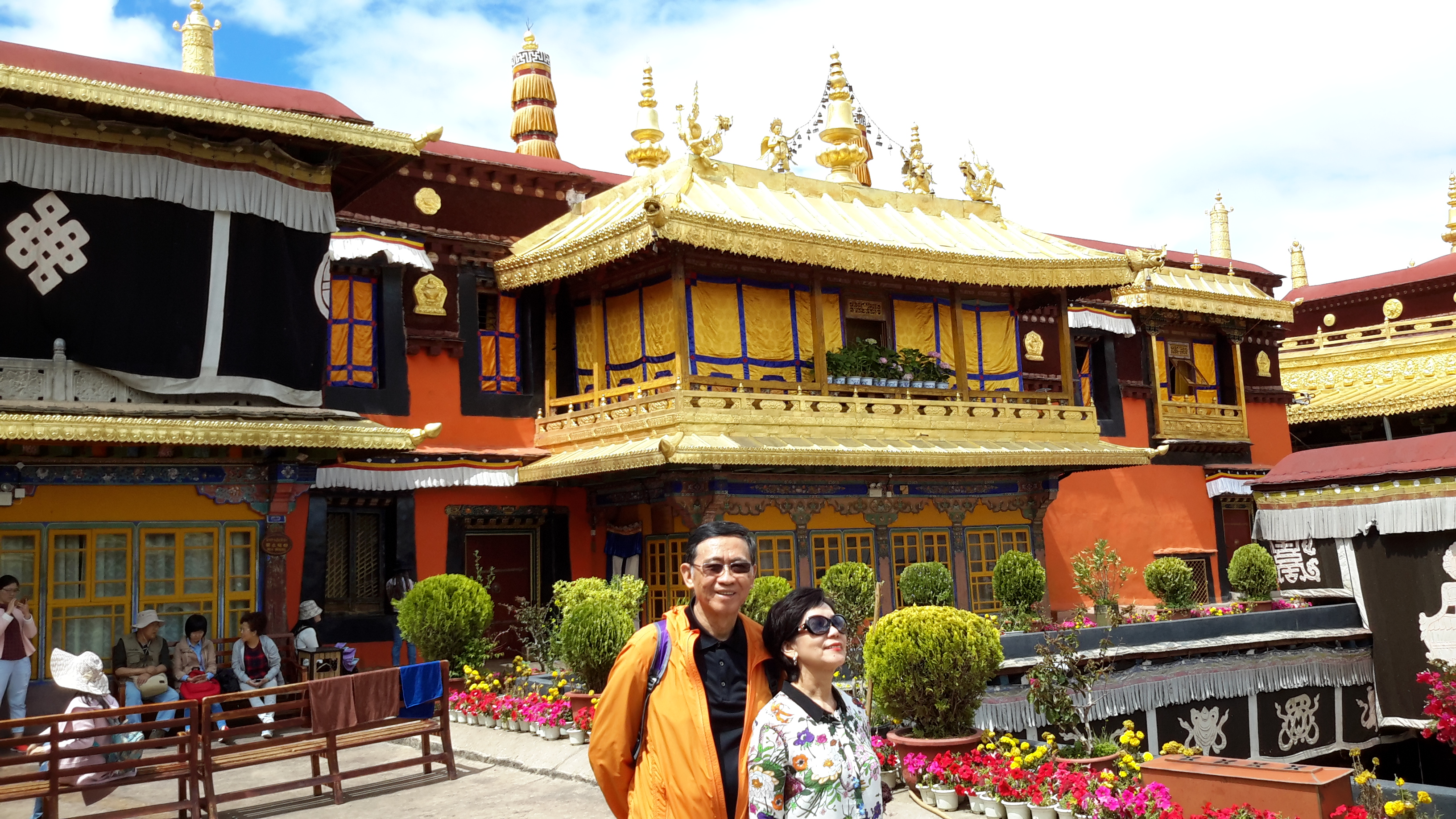
Not far from Potala Palace is Jokhang Temple which in Chinese is called Dazhao Temple 大昭寺. Located in the centre of the old town of Lhasa, it is the main place of Tibetan worship because it houses the 12-year old replica image 对身像 of Sakyamuni Buddha 释迦牟尼 brought over by Princess Wencheng from Chang'an in the Tang Dynasty. Believers offered money for gold powder which is painted over the statue. Thus over the years, the amount of gold increases as more gold was added. The temple also houses over 3,000 images of Buddha and other deities and historical figures along with many other treasures and manuscripts. It is quite clear that the Tibetans are very serious with their religion as I saw many pilgrims prostrated themselves on the ground on fours all the way in their journey to the monastery and we were told that Tibetans contributed half their wages to the Buddhist establishment for the upkeep of the monks and the buildings.
Basong Lake
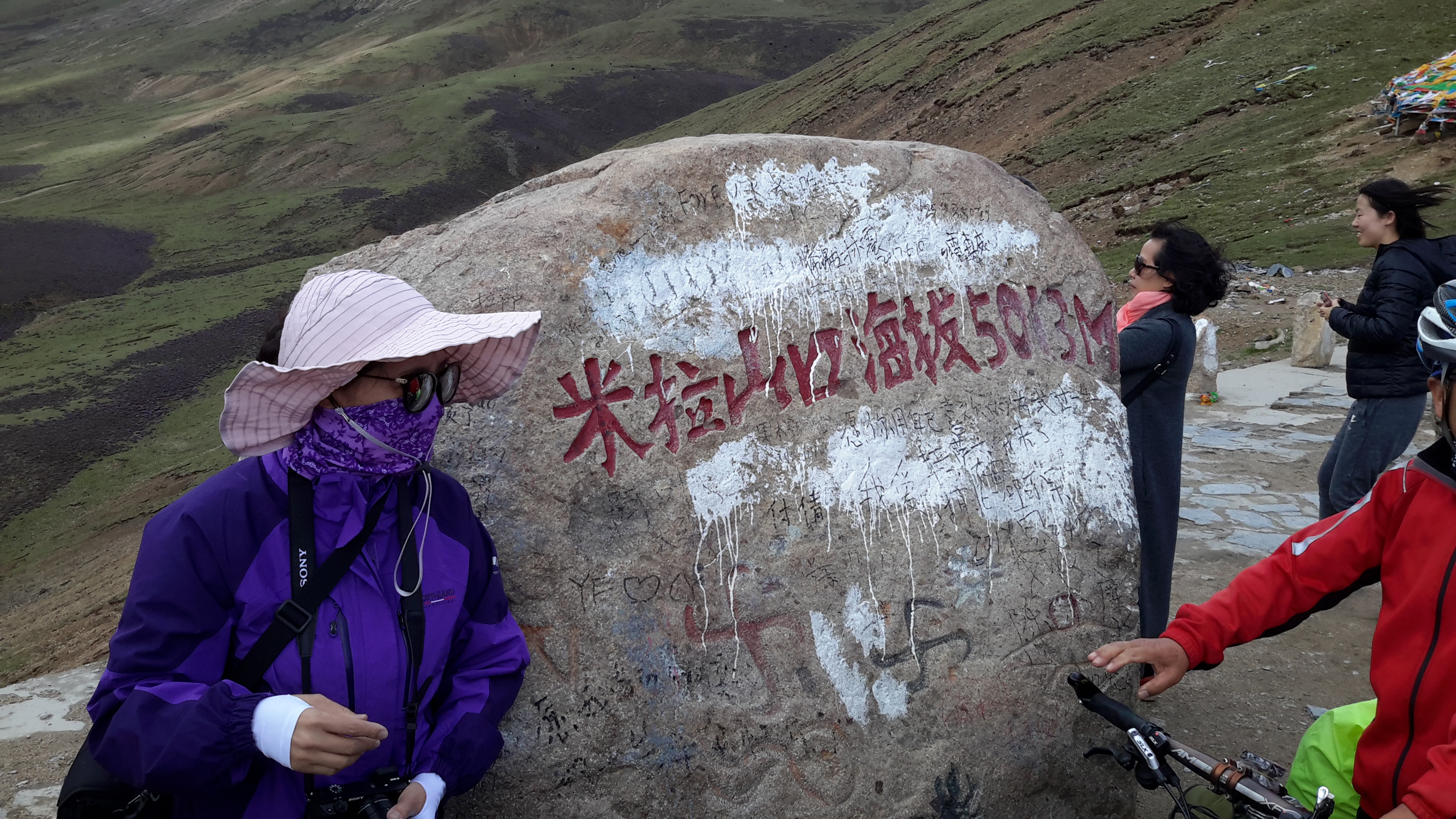
From Lhasa we took an excursion eastward along Hwy 318 to arrive Mila Mt 米拉山口 with an elevation of 5013 m. Apart from the highest point we reached while asleep in our train journey to Lhasa, this was the highest altitude we had driven so far, so everyone got out of the car and took some deep breaths. It was windy so we quickly got back into our car and drove off. As we descended along the Niyang River 尼洋河, the scenery became much more pleasing and by the time we reached Basong Lake 巴松措, we had gone down to under 4,000 m. Basong Lake is surrounded by mountains up to 6000 m high. It is a sacred lake for Tibetan Buddhism. Built in the 13th century on a small island just off the lake, adherents of the Nyingma school 宁玛派 of Tibetan Buddhism pay pilgrimage to Tsodzong Monastery 错宗寺. One startling observation I made was that the steps leading to the main hall of the monastery were guarded by a man and a woman explicitly displaying their over-sized sex organs!
Namcha Barwa Mountain
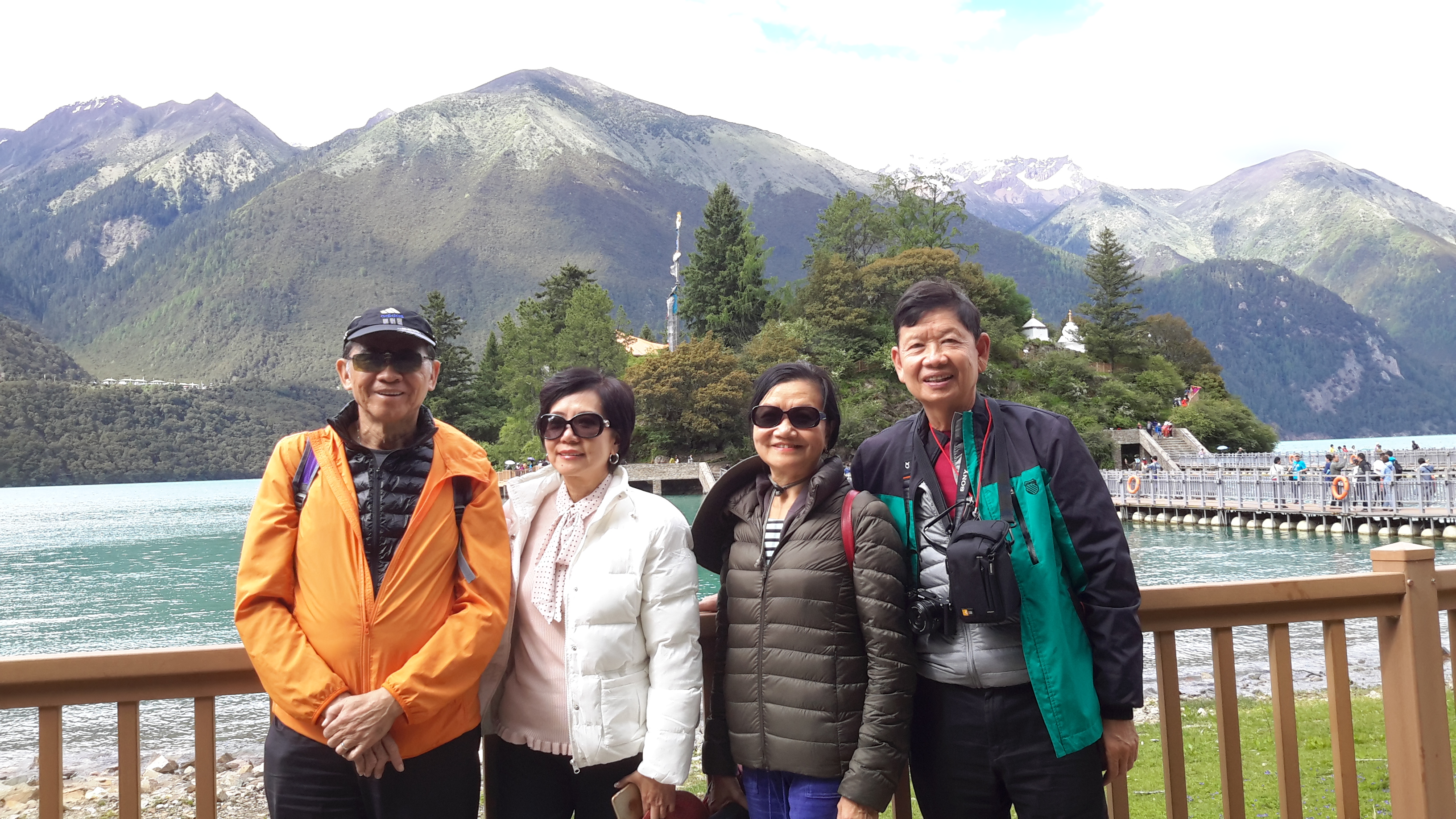
Rain disrupted our stay at Basong Lake so we made our way to Nyingchi which is the Tibetan name for Linzhi 林芝 in Chinese. After an overnight stay there we headed for the Yarlung Zangbo Grand Canyon 雅鲁藏布大狭谷which is the longest, the deepest and the highest Grand Canyon in the world. Along the way to the canyon and passing the Great Bend of the Yarlung Tsangpo River 雅鲁藏布江拐弯, the scenery was breathtaking because Namcha Barwa (Chinese Nanjiabawa 南迦巴瓦峰) is one of the most majestic mountains. Its main peak is 7,782 meters high and is the tallest peak on the east of the Himalayas. We were very lucky to catch a glimpse of its peak, albeit at a distance. A sense of euphoria hard to convey but we had made it to Namcha Barwa - a destination which most people can only dream of reaching - even at the prime of their life! Having achieved the highlight of our Tibet tour we made our way back from Nyingchi where we rested overnight before our return journey to Lhasa.
Namtso Lake
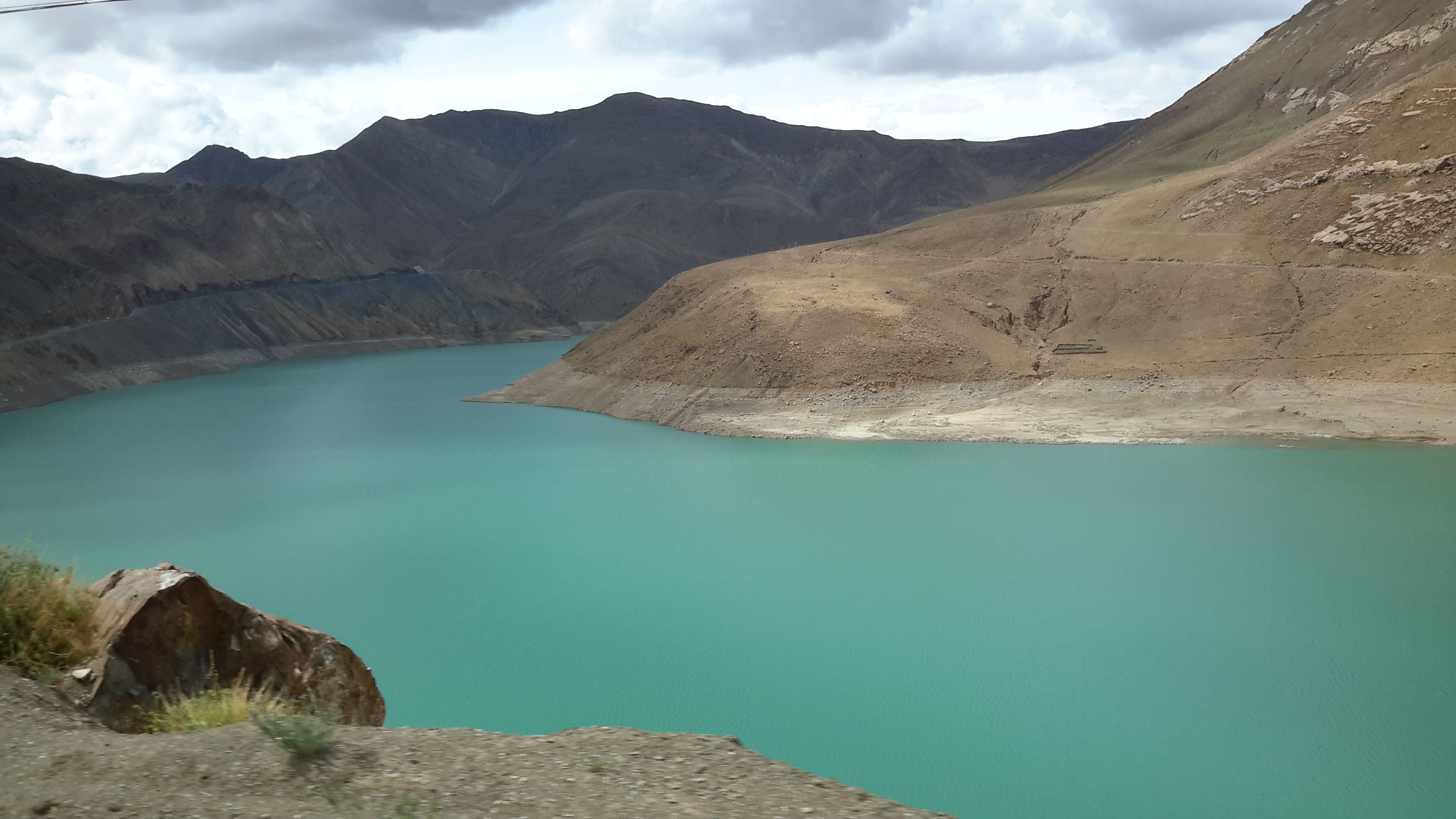
Our experience with Qinghai Lake near Xining was not altogether overwhelming so initially we were not expecting too much from this highest saltwater lake in the world. How wrong we were! True to its description of a 'Heavenly Lake', its elevation is 4700 m. To get there we had to climb La Ghen La Mountain 那根拉山 which has an elevation of 5190 m - the highest elevation which we had climbed so far in this Tibet trip. We were also lucky enough to have a bright sunny day to view the crystal clear blue water - a benefit denied of us on the day we visited Qinghai Lake! Another factor was the snow-capped mountain and open grassland in the background, dotted with yak herds and local nomads. It was indeed one of the most beautiful places in Tibet. We traveled on the highway along the same train route as our journey from Xining to Lhasa 青藏公路, passing the Dangla Mountain range(Tanggula Mountains in Chinese), so it was not surprising that we could view its main peak at an elevation of 7117 m. How small and insignificant we were when compared with nature!
Tashi Lhunpo Monastery
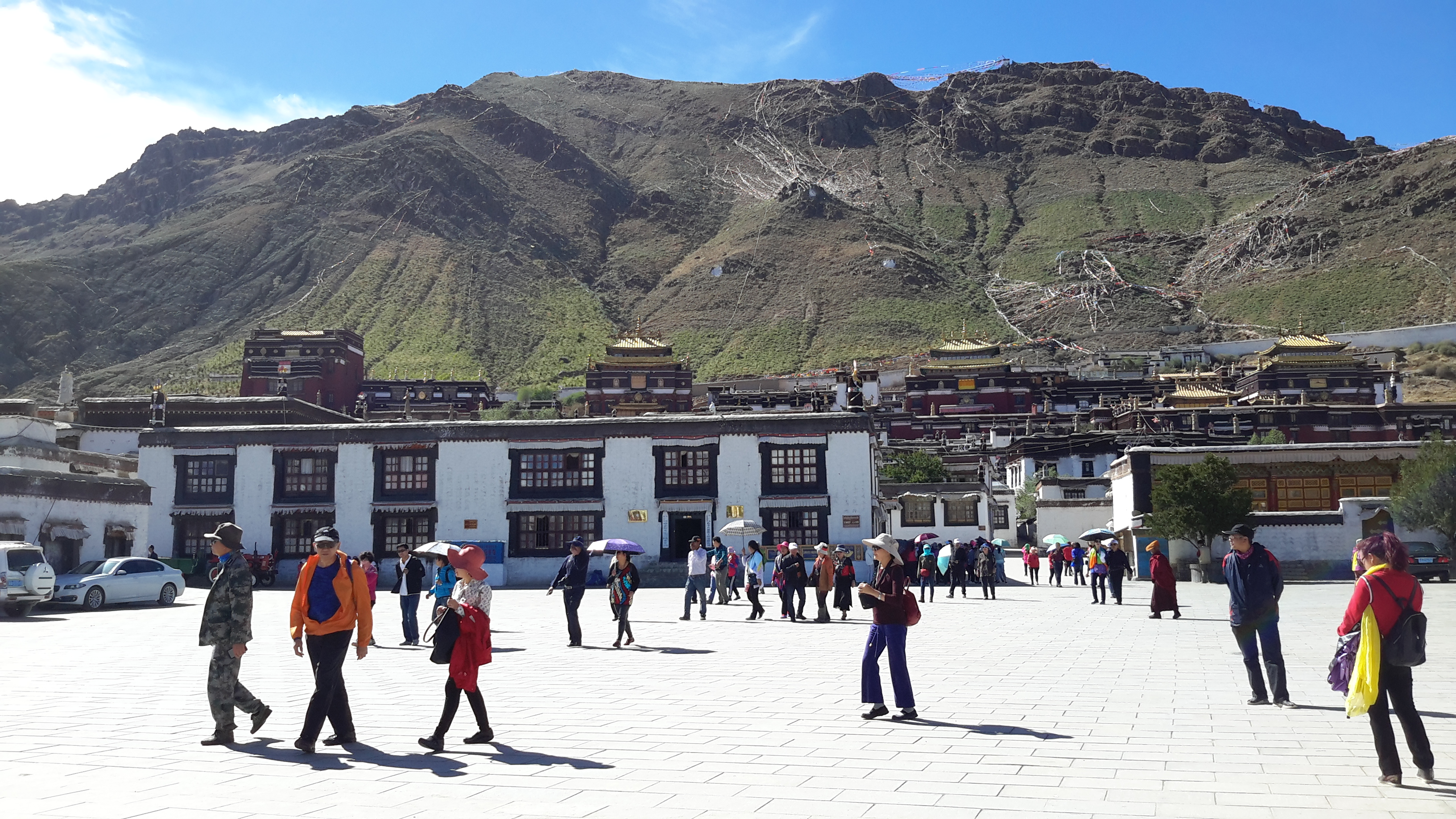
It was time to visit the shrine of the Panchen Lama 班禅喇嘛 - Tashi Lhunpo Monastery 扎什伦布寺. Standing at the entrance we saw grand buildings with golden roofs and white walls. Founded in 1447 by the 1st Dalai Lama, the monastery is the traditional seat of successive Panchen Lamas, the second highest ranking tulku 活佛lineage in the Gelug tradition 格鲁派 of Tibetan Buddhism. Three temples attracted our attention: 1. The Maitreya Temple houses a 26.2 metres high statue of Maitreya Buddha 彌勒菩薩which contains 279 kg of gold and 150,000 kg of copper and brass mouded on a solid wooden frame. 2. The Stupa-tomb of the 10th Panchen Lama which is covered by 614 kg of gold and countless semi-precious stones. 3. The Kelsang Temple with a Chanting Hall where lamas learn the sutras and listen to the Panchen Lama's sermons. Altogether there were 500 monks living in the monastery.
Yamdrok Yumtso Lake
We rounded off our Tibet trip by driving around its most beautiful lake, the Yamdrok Yumtso Lake. The Chinese name is Yangzhuoyongcuo Lake 羊卓雍错湖 or Yang Lake 羊湖 for short. It is the largest lake in South Tibet. We traveled along the lakeshore to admire its turquoise water. With snow-capped mountain in the background and grassland in the foreground it made the best pictures that you can ever imagine.
Karola Glacia
After lunch we took 2 hours to climb the Gampa Pass 岗巴拉山口 leading to the Karola Glacia卡若拉冰川which gave us an elevation of 5,030 m when we reached there. Our guide pointed at a distance and told us that beyond this range of mountain is the Friendship Highway leading to the Chinese-Nepal border. I paused momentarily and thought to myself: I wouldn't mind continuing on the highway but what about my travel companions? Karola Glacia is not a big glacier by any standard, but it was only 300 yards from the highway. There was a stupa and prayer streamers at the base of the Glacier and Tibetans selling souvenirs and posing for photos. Other than that there was not much to do from the roadside so we didn't stay long. My travel companions including my wife were getting fatigue syndromes, not so much altitude sickness. It's time to go home. We passed the Gampa Pass and the scenery turned green again as we started our descent back to the Shigatse plain and from there continued our return trip back to Lhasa.
Goodbye to Lhasa and to Ming and Helena
Our 12 days tour of Tibet was like a never-ending dream - a trip of a lifetime. Magdalen was not an adventurer and I would never have persuaded her to come along with me without Ming's efforts in organising the trip and Helena's supportive companionship. We said goodbye to the Chans at Lhasa with another promise of a future adventure: Iran in September 2018!





